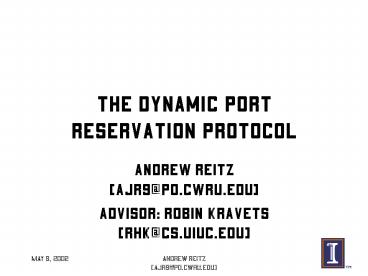The Dynamic Port Reservation Protocol PowerPoint PPT Presentation
1 / 24
Title: The Dynamic Port Reservation Protocol
1
The Dynamic Port Reservation Protocol
- Andrew Reitz (ajr9_at_po.cwru.edu)
- Advisor Robin Kravets (rhk_at_cs.uiuc.edu)
2
The Internet Today
- Much to the chagrin of the technical community,
the Internet is still based on IPv4. - Technologies like Network Address Translation
have gained prominence, lengthening the life of
IPv4. - Rate of adoption for IPv6 is slow.
3
Network Address Translation
- Allows one valid public IP address to be shared
by many machines, via a gateway that dynamically
modifies source and destination IP address and
port numbers of packets that traverse it. - Breaks the one-to-one IP address to Internet host
model. - Establishes the notion of public versus private
hosts.
4
The Benefits of NAT
- In general, NAT works well for the most prevalent
Internet applications - Web, E-mail, FTP (passive mode), streaming
audio/video, etc. - Security is increased, because unsolicited
in-bound connections are not permitted to private
hosts, and because the presence of private hosts
is occluded.
5
The Problem With NAT
- In the last several years, there has been a large
growth in applications that demand unsolicited
in-bound connectivity - All peer-to-peer applications (file sharing,
instant messaging, personal video conferencing,
multiplayer games, etc.). - Security protocols, like IPsec.
- Prominence from Napster Bubble.
6
Potential Solutions
- This problem has been solved, in various ways,
by several other people/groups - Dan Kegel published a UDP Hack
- The IETF is working on Realm-Specific IP
- Eugene Ng (CMU) created the Address
Virtualization Enabling Service (AVES).
7
Dan Kegels UDP Hack
- Relies upon UDPs connectionless nature, and NAT
gateways ability to preserve port numbers. - Private hosts learn of each others public IP
address and port via 3rd party. - Each host begins sending UDP datagrams to each
others public IP, forging enough state in each
NAT gateway for connection.
8
(No Transcript)
9
Pros and Cons of UDP Hack
- Pros
- Minimal set of changes to existing Internet
infrastructure. - Can be added by application developers on an
as-needed basis. - Cons
- Fails when NAT gateway must translate ports.
- Only works with UDP.
10
Realm-Specific IP
- A new IETF draft, which aims to restore complete
connectivity to private hosts. - An RSIP-enabled host can obtain a lease on a
public IP address from an RSIP-enabled gateway. - Host builds public packets, passes to gateway
via tunnel, which injects the packets into the
network.
11
(No Transcript)
12
Pros and Cons of RSIP
- Pros
- Restores complete connectivity for private hosts
even IPsec works. - Cons
- Requires extensive infrastructure modifications
private host IP stack, NAT gateway, application
modification. - Public IP address pool weakens NAT address
conservation gains.
13
AVES
- Connectivity for NAT-friendly applications.
- Private hosts are enumerated in DNS.
- DNS server works in conjunction with waypoint
server, to establish a private to public address
mapping. - Waypoint server tunnels traffic bound for private
host to NAT gateway.
14
(No Transcript)
15
Pros and Cons of AVES
- Pros
- Transparent to existing hosts.
- Supports public servers behind NAT.
- Cons
- DNS maintenance adds complexity.
- Public IP pool exhaustion is DoS.
- Ingress filtering at edge router requires all
traffic to be forwarded through waypoint.
16
Room For A Better Method
- The ideal solution makes it easy to support the
widespread of applications (P2P). - Must support TCP and UDP.
- In order to be deployable, cannot modify host IP
stack or Internet routers. - Shouldnt require extra infrastructure, such as
proxies that dont scale or can fail.
17
Enter DPRP
- Aim is to make the port forwarding functionality
of most NAT gateways more accessible. - Develop protocol, so that applications can signal
NAT gateway to reserve port. - Apply DHCP techniques for managing reserved ports.
18
More Explanation
- DPRP allows end-users to reserve specific TCP or
UDP ports on the NAT gateway. - Unsolicited in-bound packets to reserved port are
redirected to private host. - Port reservation takes form of lease.
- Address/Port can be advertised through normal
channels (URL, P2P registry, etc).
19
(No Transcript)
20
Sample Implementation
- Client and server were written in Java.
- GUI client allows end-users to reserve ports for
legacy applications (web servers, etc). - Java Napster client, XNap, was modified to
include DPRP client functionality. - Java DPRP server interacted with NAT gateway via
iptables commands.
21
Security Implications
- DPRP doesnt poke any new holes in NAT gateway,
it simply moves port forwarding from
administrator to user control. - Only as secure as applications.
- Adminstrator has controls over DPRP use.
- DPRP-enabled worms could pose problems.
22
Microsoft Stole My Idea
- It appears as if a new technology called
Universal Plug n Play incorporates all of these
ideas. - UPnP is a network service discovery platform.
- Network elements can query each other, in order
to disseminate capabilities.
23
UPnP NAT Traversal Solution
- A subset of UPnP, that purports to provide the
following services - Discovery of public IP address.
- Enumeration of existing port mappings.
- Addition and removal of port mappings.
- Assignment of lease times to port mappings.
- Goes the last mile, and takes care of the
transparency problems that DPRP had.
24
Conclusion
- DPRP accomplished initial goals, in terms of
application support (TCP UDP) and
deployability. - Further technical analysis of UPnP needed.
- Will IPv6 ever see mass-acceptance?

